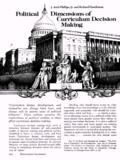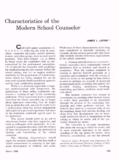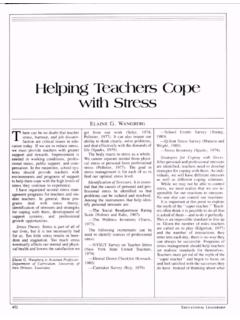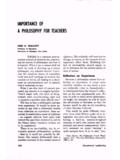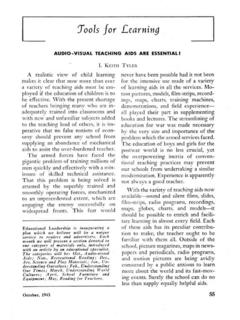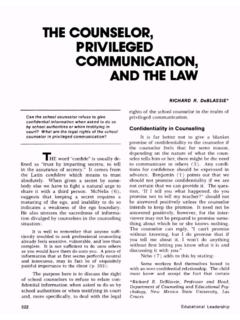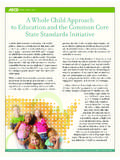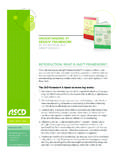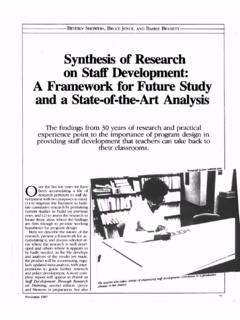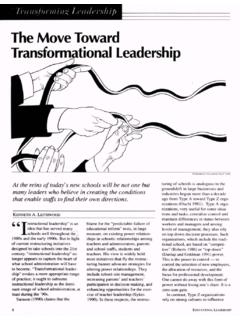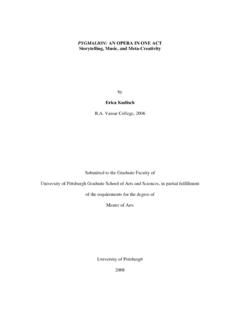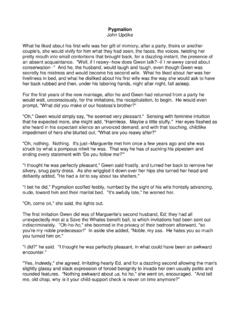Transcription of The Expectations of Pygmalion's Creators - ASCD
1 The Expectations of Pygmalion's Creatorsthe publication of P = ~ = = =` ~ = y Robert Rosen- thal and Lenore Jacobson, preliminary articles and conference speeches reported to the educational public the authors' view that teachers' Expectations appear to affect their pupils' intellectual development.'This major thesis was not unexpected by many educators because of the feeling in a large segment of the professional community. This climate could be characterized as having a perceptual approach to epistemology, a transactional approach to interpersonal rela tions, and a self-concept approach to devel opmental process. The pygmalion study slipped into this intellectual milieu with very little dissonance.
2 Further, it appeared to be buttressed by internal consistency that re flected further Expectations of the society at large; for example, teachers' Expectations apparently had a differential effect upon minority group marked contrast to this initial recep tion was the immediate response of the pro fessional community to another study .which seemed to be addressed to a similar issue: "How Much Can We Boost IQ and Scholastic Achievement?" - Harvard professor Arthur Jensen's thesis is that measured intellectual differences between races are based on real1 Robert Rosenthal and Lenore Jacobson. P L~J= = = =` ~ K=k ew York: Holt, Rinehart and Winston, Arthur R. Jensen. "Ho\v Much Can We Boost IQ and Scholastic Achievement?
3 " H ~ ~ =b ~ ~ =o =P 9 (1): 1-124: Winter 1969.`e^oilqqb=mK=q^viloGgenetic differences. This study, however, is in radical opposition to prevailing social ex pectations. In two issues of the H ~ ~ =b ~ ~ =o =~ nd bulletin of ERIC Information Retrieval Center on the Disad- vantaged "the big guns" of the educational establishment massed an attack on Jensen's unpopular hypothesis.'Rosenthal and Jacobson elected to pre sent the full development and analysis of their experiment in a form aimed somewhere between layman and expertly trained experi menter. For example, raw data are not included in P ~ = = =` ~ K=mer haps this is another reason that rigorous evaluations of the study have been few.
4 Nevertheless, three studies appearing in the professional literature 4- r' " have raised such;! See: H ~ ~ =b ~ ~ =o =P9 (2 and 3>: also Io`a=_ =R= EQFW=N -24: Fall 1969. New York: ERIC Information Retrieval Center on the Disadvantaged, Horace-Mann Lincoln Institute, Teachers College, Columbia William L. Claiborn. "Expectancy Effects in the Classroom: A Failure To Replicate." j ~ = =b ~ ~ =msi/c/ 60 (5): 377-83; October 1969. "' Peter Gumpert and Carol Gumpert. "The Teacher as pygmalion : Comments on the Psychol ogy of Expectation." U ~ =o =P=(1): 21-25; September Robert L. Thorndike. Review of Rosenthal and Jacobson, P ~ = = =` ~ K=^ = ~ =b ~ ~ =o ~ =g ~ =R=E 4): 708-11; November 1968.
5 * C ~ =mK=q~ K=a = =f I=k J~ =p =a K=k ~ I=a ~ J~ k =NVTM161serious questions about the validity of the pygmalion data and their statistical analysis that the conclusions of the entire study seem in doubt. Those readers of E ~ ~ =i ~ = = ho can find their way about in the sophistication of statistics would do well to study these reports a cursory review, however, sug gests serious scientific impediments to accept ing Roscnthal and Jacobson's To ReplicateCentral to the scientific method is the criterion that an experiment's reliability is based on the ability of other scientists to repeat it and arrive at the same results. Two replication studies are cited in P ~ = = =` ~ K=lne conducted by Judy Evans using a similar design in another school re sulted in what the authors themselves call a "dramatic and very highly statistically sig nificant reversal.
6 " 'As supportive replication, Rosenthal and Jacobson offer results from a doctoral dis sertation by W. Victor Beaz. In this study, teachers expected good or poor symbol learn ing from individual Head Start pupils. Those teachers who expected good learning "tried to teach more symbols to their pupils than did the teachers given unfavorable expecta- tioiis." * Change in test behavior was mea sured on a performance test of symbol learn ing the exact skill which teachers did or did not attempt to teach. It is claimed, however, that (unidentified) measures of statistical control removed the influence of this instruc tional factor and a significant difference in achievement an experiment of two months' dura tion between pre- and post-tests, using 12 first-grade classrooms and the Test of General Ability (TOGA) which Rosenthal and Jacob- son had used, Claiborn failed to replicate the findings of the pygmalion study.
7 '1 An impor tant difference in his procedure may have been the attempt to control initial pretest dif ferences which, as is shown below, had a" Rosenthal and Jacobson. op. c KI= . f KI= K=N Claiborn, op. c Kbasic influence upon the pygmalion results. Claiborn's article is also worthwhile for high lighting the major errors in statistical analysis which characterize not only the manipulation of the pygmalion data but previous laboratory expectancy studies con ducted by Rosenthal from which the within- school study of InteractionsIn 1968, the U ~ =o = aired the key chapter of P ~ I=? The Magic Chil dren of Galatea," with a critical analysis by Carol and Peter Gumpert.'" While "concur ring that the analysis of the data as presented supported the major hypothesis," the Gum- pens raised questions about the interactions of factors such as sex which were the focus of many of the Rosenthal and Jacobson sub- conclusions.
8 For example, ".. how the strength of teacher expectation varied with the sex of the students, their group status E minority or otherwise), their ability track, and so on is a complex and confusing busi ness. It is fairly easy to interpret each result taken alone, but the reader who attempts to make his interpretations consistent with one another will be in for a good deal of diffi culty.." " Basic IQ data, for example, are not presented by the pygmalion data as given for the effect of individual classroom, the Gumperts found a significant variable unrec ognized by Rosenthal and Jacobson. How much influence was caused by classroom atmosphere and interaction, by peer- and self- esteem? Before discussing suggestive fac tors which may create an expectation bias, the Gumperts also score the pygmalion study's far too great reliance upon the validity of pretest scores and the authors' confusion of s ~ = f statistical significance levels with the m ~ = f a statistical of DataAt once the most concise and most de cisive criticisms of P ~ = = =` ~ J'" Gumpert and Gumpert.
9 Op. c K=11 I KI= K=O ~ ~ =i ~ = ere presented by Robert L. Thorndike in the November 1968 issue of the A ~ =b ~ ~ =o ~ =g ~ KG?=^=year later, Rosenthal responded in the same journal.'3 Thorndike focused on just one cell of the pretest data which reported that 19 first- grade children had a mean IQ of 31 on the subtest score of reasoning. Since the children tested were at the bottom of the TOGA age span, extrapolation alone (based on only two correct responses) could suggest an IQ of 31. This score combined with the other classes resulted in a mean reasoning IQ of 58 for the entire first- and second-grade responded, however, that since Thorndike focused on the reasoning scores, he apparently accepted the total scores as accurate.
10 This is an unlikely and inap propriate rebuttal since the total IQ score on TOGA is a simple addition of the subscores of verbal concepts and reasoning an error of one guarantees an error in the , Rosenthal countered that 15 of 17 classrooms showed the pygmalion bias on the reasoning IQ or 13 out of 14 if one omitted the first and second grades. (One of these differences shows statistical signifi cance.)Thorndike also questioned a mean post- test IQ of 150 for six second-grade "bloom ers." This would have demanded that the pupils got a = uestions correct on TOGA. How then could an accompanying standard deviation of 40 suggest some pupils had scored m = han a = orrect?Rosenthal's response: "Their mean IQ was simply times the magnitude of their mean CA.
